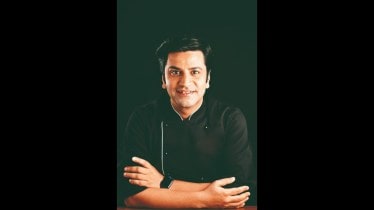Kunal Kapur dons many hats. Apart from being a celebrity chef and a MasterChef host-cum-judge, he is also a restaurateur, content creator, and author of two books. ‘I am not somebody who can stick to one thing and keep doing that my whole life,’ he says. However, a common thread that runs through all of this is his work for Indian cuisine, whether bringing forth fading dishes and ingredients, presenting desi food in gourmet form, or giving simple kitchen hacks that make him a popular social media figure with a massive following. This was vividly visible at the recent Jackfruit Festival at his Noida-based restaurant Quarter Plate
Both your restaurant chains Pincode and Quarter Plate focus on Indian cuisine. What are the new trends developing in Indian cuisine? What aspects of it remain unexplored?
A new trend emerging is the focus on regional and local flavours, along with the use of lesser-known ingredients and styles of cooking, which were earlier restricted to certain regional homes or streets of India. These are being brought to the mainstream by the chefs introducing them in their restaurants.
Also, I think the entire trend of desi going gourmet has caught everybody’s attention.
The less explored remains the old Vedic style, or what we call the satvik style, which is based on Ayurveda. Here, I would also like to highlight the future course of action, which should be more responsible cooking, by which I mean less wastage, using ingredients that are available close by, so that you leave a low carbon footprint. Also, there’s a need to offer people a fair option to choose from your menu where certain dishes could be high in calories but you balance it out by offering dishes that are low in calories and high in nutrition.
You chose Dubai for the first outlet of Pincode. How’s the restaurant doing? Is the Dubai market witnessing some level of saturation when it comes to Indian cuisine?
The restaurant is doing well. The reason that I chose Dubai is first, it has a large Indian expatriate community, and also, most local Arabs in the UAE are aware of Indian food, so it’s not difficult to make them understand what Indian cuisine is. So it made logical sense to have a restaurant there. Also, the city is growing at a rapid pace, so everyone naturally wants to have a slice of the Dubai pie.
But that also leads to a lot of competition, as every six months, you see a new restaurant opening in the same category as yours.
All in all, it’s an interesting market that keeps you on your toes, making you innovate and improve your products constantly, whether it’s food, service, or ambiance.
I see that a restaurant that establishes itself well in the Middle East, especially in the UAE, has a greater chance of success as it heads to Europe and other continents.
How was the experience cooking for the First Ladies at last year’s G-20 Summit held in India?
It was an exhilarating experience, curating the menu, and keeping individual preferences in mind, especially since there were so many of them. On top of that, you need not change your food or the cuisine, tone down, or modernise anything. You need to bring out the most classical things in your dishes and pair them with ingredients from across India. And that’s exactly what I did. It’s a rewarding experience as you feel a sense of pride representing your cuisine, nation and people.
Also, I feel eating is a very humbling experience. It’s a time when you’re no longer discussing war, economy, or such matters, but you start talking about your experience with the food. It’s always a great conversation starter.
For example, at the G-20 Summit, I made Jowar ka Khichda, and Akshata Murthy, then first lady of the United Kingdom, instantly remembered that it was something her daadi (grandmother) used to make, and she used to eat it as a kid.
You have built a massive social media following. What has social media taught you regarding your culinary journey?
Social media has taught me to be authentic and honest. And by that I mean, you can neither put out half-baked recipes nor half-baked knowledge as people would see right through that, as people will try that and talk about it. At the same time, it has a huge educational quotient, especially since with social media you can reach any part of the world. It also helps you keep up with the latest trends.
Having said that, an important thing that stands out for me is personal growth. Social media allows me to creatively express myself, and build a community.
You don multiple hats. You are a celebrity chef, a restaurateur, a MasterChef judge-cum-host, a writer, and a content creator. Which of these roles do you enjoy the most and why?
I am not someone who can stick to one thing and keep doing it my whole life. I like variety. And food fits perfectly in the mix. Whether it is hosting a show like MasterChef, being a content creator, or a restaurateur, or writing a book. I enjoy all these roles, as they give me spaces to express myself in different ways, and when combined, they just strengthen my food portfolio.I don’t have a favourite. I just skip from one to the other.
— As told to Shubhangi Shah
